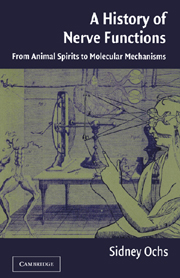Book contents
- Frontmatter
- Contents
- Preface
- 1 Introduction: Greek Science and the Recognition of Nerve as a Channel
- 2 Galen's Physiology of the Nervous System
- 3 Nerve, Brain, and Soul in the Middle Ages
- 4 Renaissance and the New Physiology
- 5 New Physical and Chemical Models of Nerve in the Enlightenment
- 6 New Systematizations of Nerve Function in the Enlightenment
- 7 Electricity as the Agent of Nerve Action
- 8 Nerve Fiber Form and Transformation
- 9 Wallerian Degeneration: Early and Late Phases
- 10 Nerve Regeneration
- 11 Characterization of Axoplasmic Transport
- 12 Molecular Models of Transport
- 13 Actions of Neurotoxins and Neuropathic Changes Related to Transport
- 14 Purposeful Reflexes and Instinctive Behavior
- 15 Neural Events Related to Learning and Memory
- 16 Epilogue: With Observations on the Relation of the Nervous System to Mind
- Bibliography
- Index
12 - Molecular Models of Transport
Published online by Cambridge University Press: 13 August 2009
- Frontmatter
- Contents
- Preface
- 1 Introduction: Greek Science and the Recognition of Nerve as a Channel
- 2 Galen's Physiology of the Nervous System
- 3 Nerve, Brain, and Soul in the Middle Ages
- 4 Renaissance and the New Physiology
- 5 New Physical and Chemical Models of Nerve in the Enlightenment
- 6 New Systematizations of Nerve Function in the Enlightenment
- 7 Electricity as the Agent of Nerve Action
- 8 Nerve Fiber Form and Transformation
- 9 Wallerian Degeneration: Early and Late Phases
- 10 Nerve Regeneration
- 11 Characterization of Axoplasmic Transport
- 12 Molecular Models of Transport
- 13 Actions of Neurotoxins and Neuropathic Changes Related to Transport
- 14 Purposeful Reflexes and Instinctive Behavior
- 15 Neural Events Related to Learning and Memory
- 16 Epilogue: With Observations on the Relation of the Nervous System to Mind
- Bibliography
- Index
Summary
The characteristics of transport discussed in the preceding chapter were shown to depend on the energy supplied by oxidative metabolism. In this chapter, models advanced to account for how that energy is utilized for the movement of proteins, and the vesicles and other particles visualized by means of allen video-enhanced contrast differential interference contrast (AVEC-DIC) microscopy, are described. The view that has emerged is that all these materials are moved out along the microtubules by specific “motors.” The development of this model of fast transport is described in this chapter.
Slow transport on the other hand has remained a matter of contention. The old view that axoplasm moves down in bulk (Chapter 11) was replaced by the hypothesis that only the microtubules and neurofilaments are moving down at the slow rate. An opposing theory holds that these cytoskeletal organelles are stationary in the fibers with their protein subunits moving in the fluid axoplasm. The question raised is whether this requires the presence of a different mechanism of transport other than that serving for fast transport with the further complication that, in addition to fast and slow transport, a number of intermediary transport rates have been found. The hypothesis that a single mechanism termed the unitary hypothesis, can account for all the different transport rates will be taken up at the end of the chapter.
- Type
- Chapter
- Information
- A History of Nerve FunctionsFrom Animal Spirits to Molecular Mechanisms, pp. 263 - 283Publisher: Cambridge University PressPrint publication year: 2004



